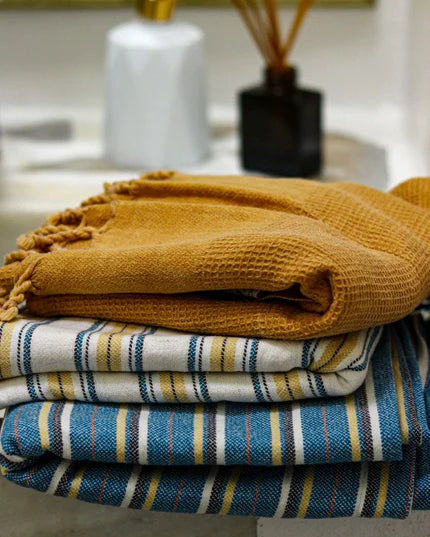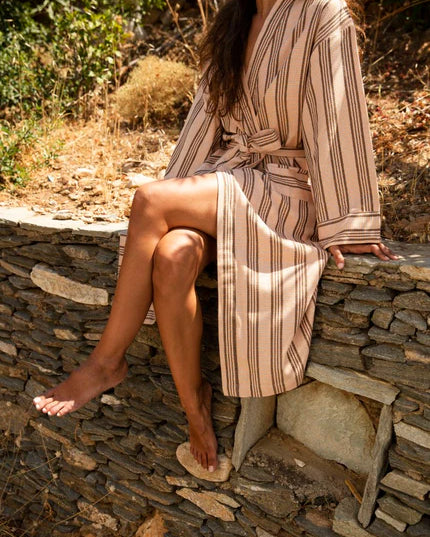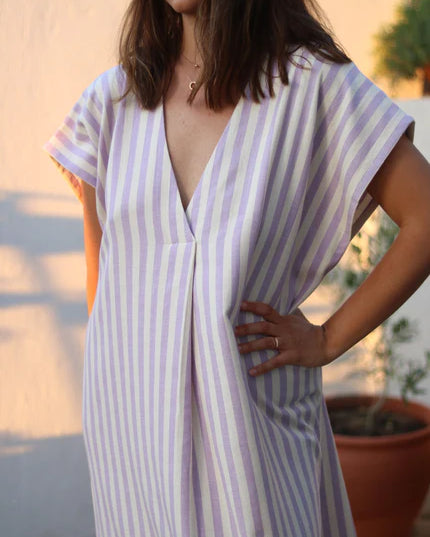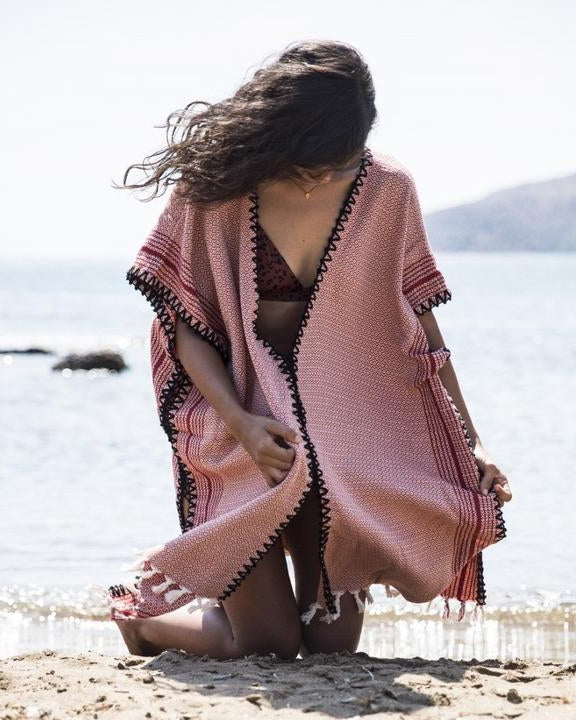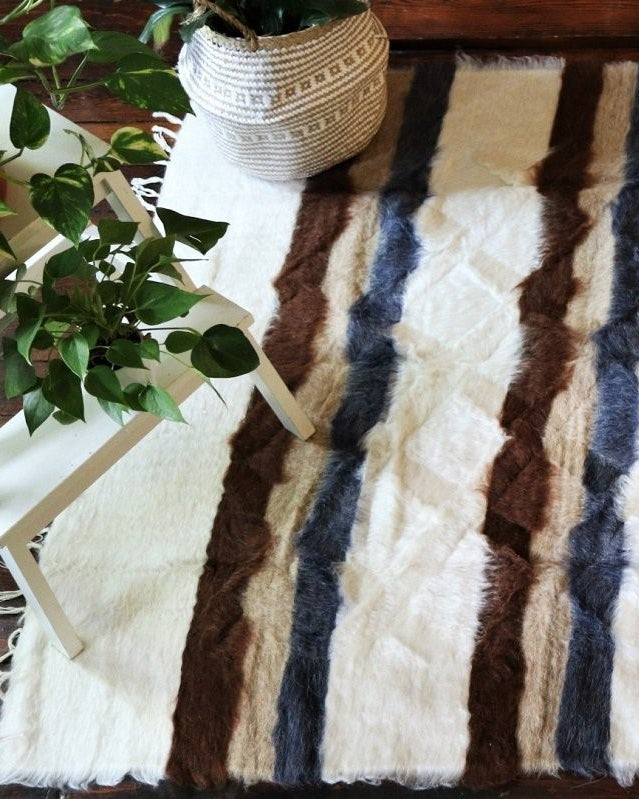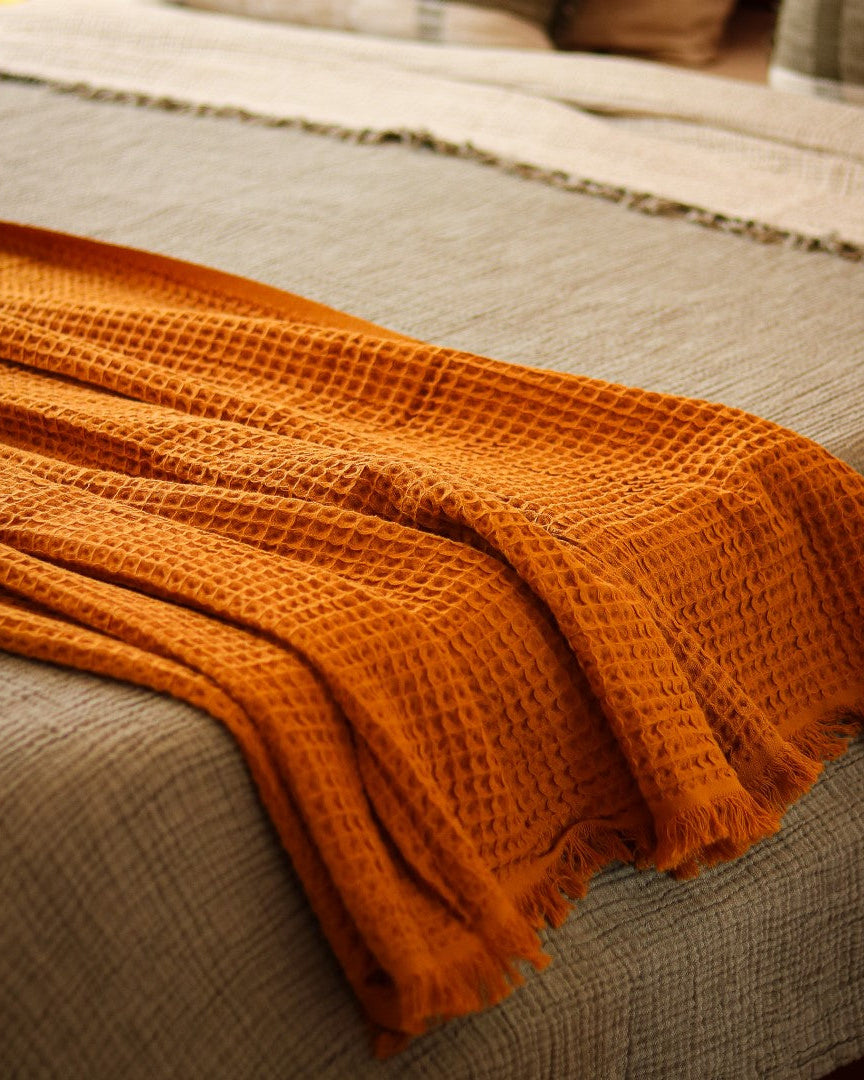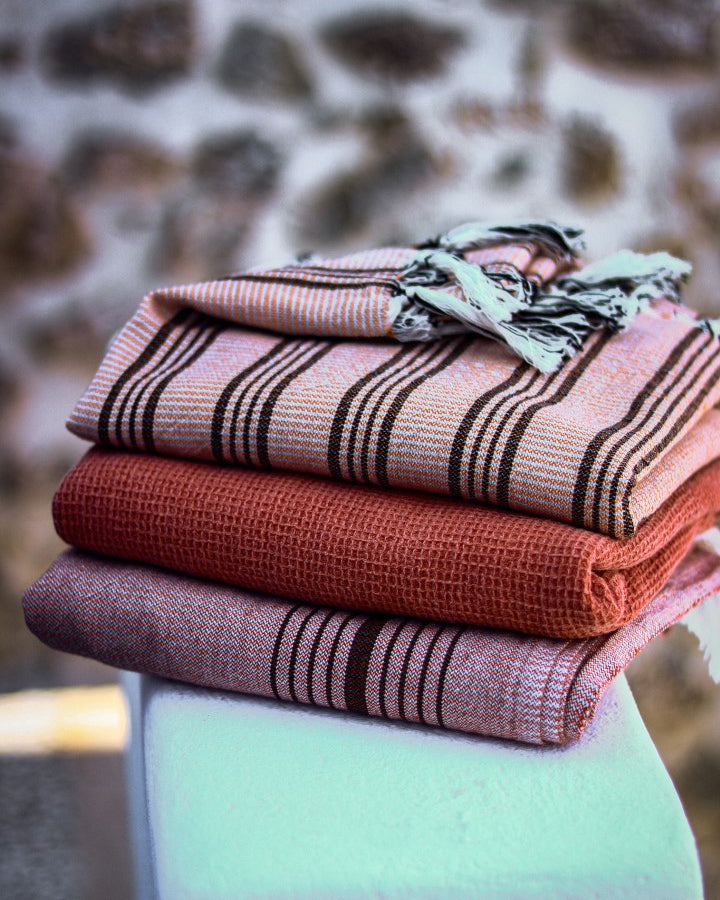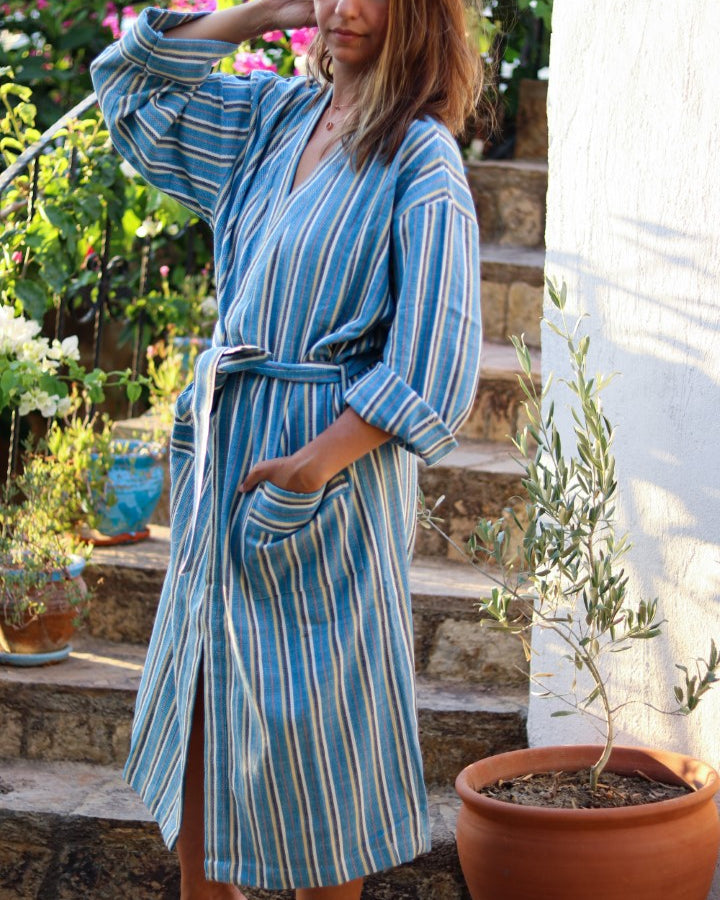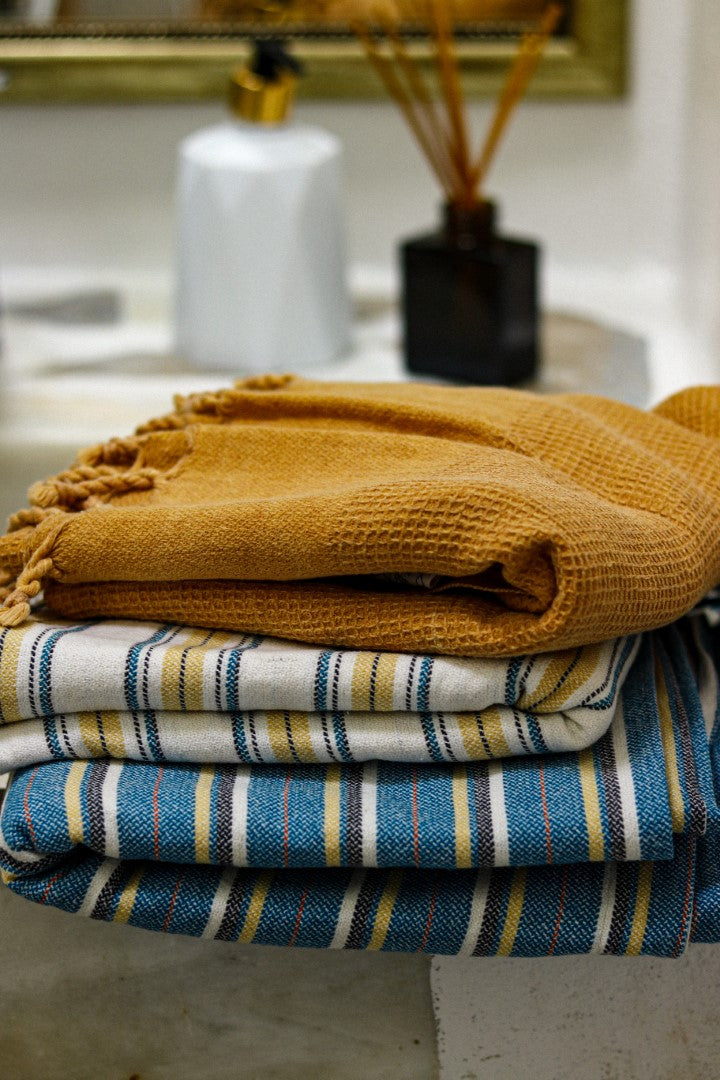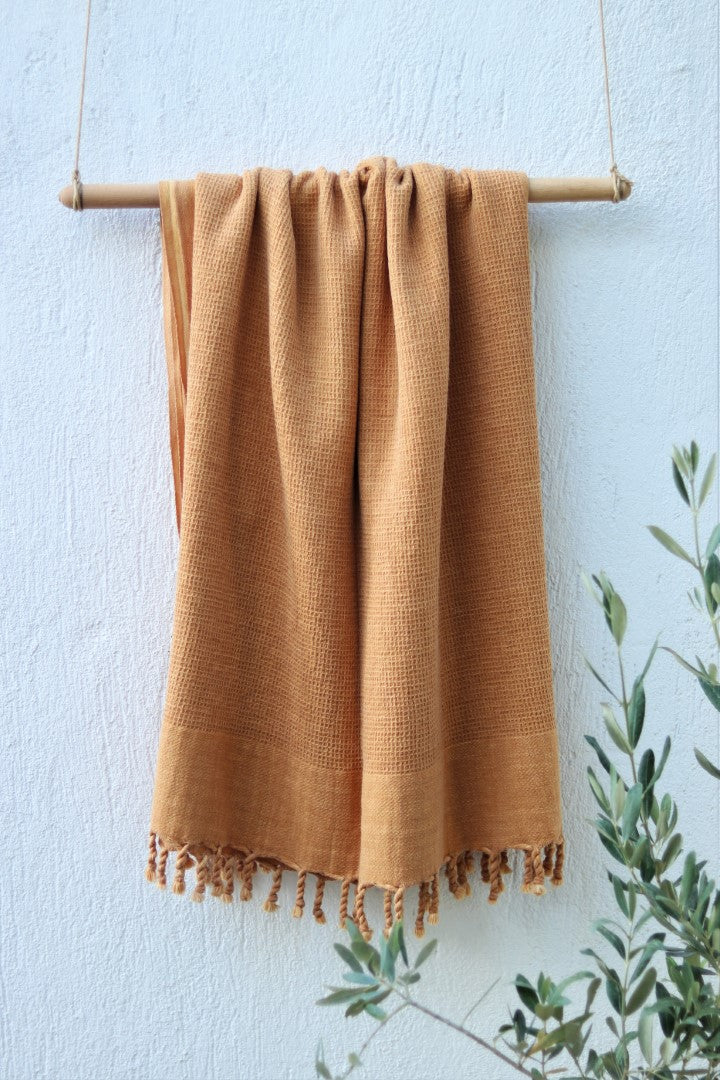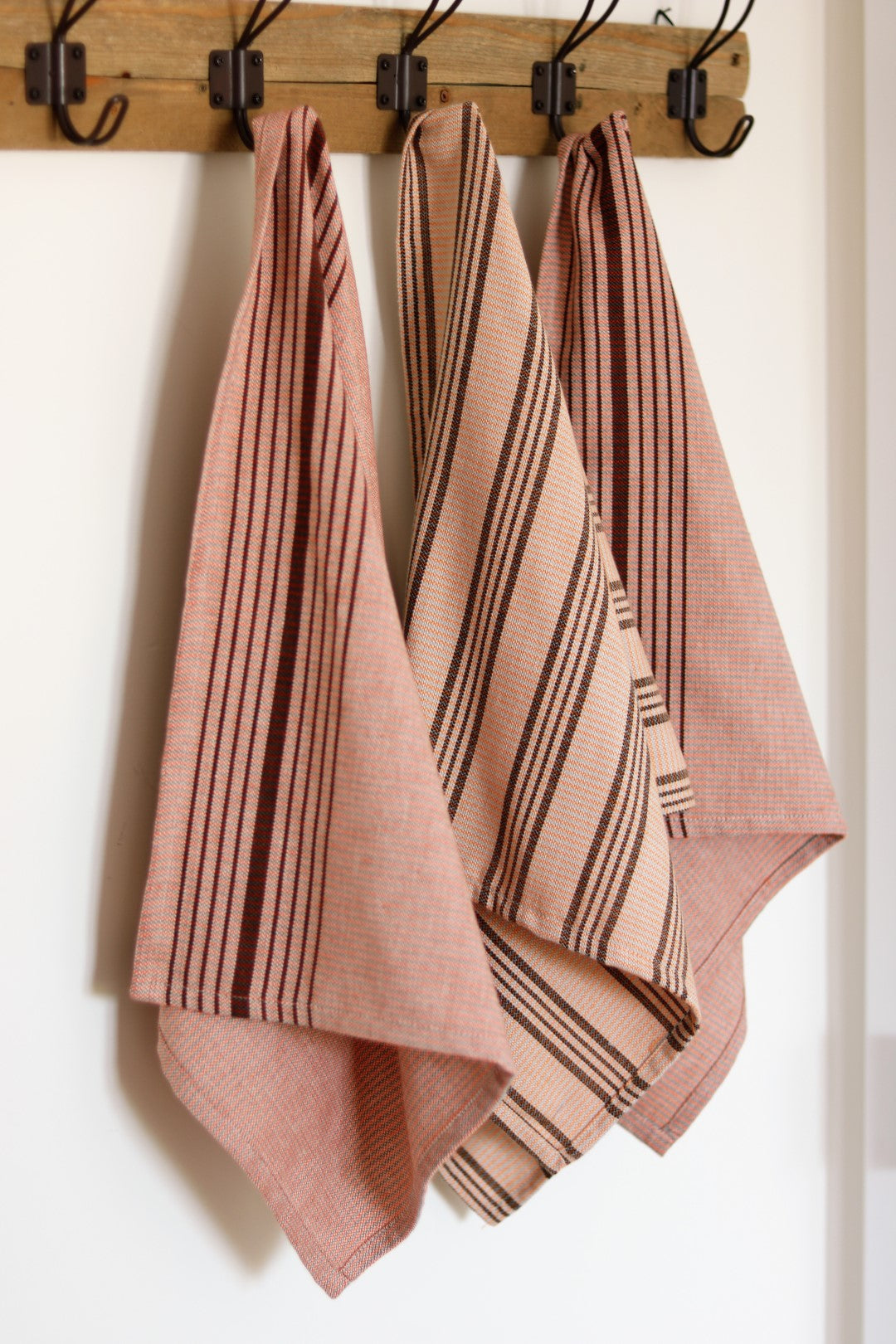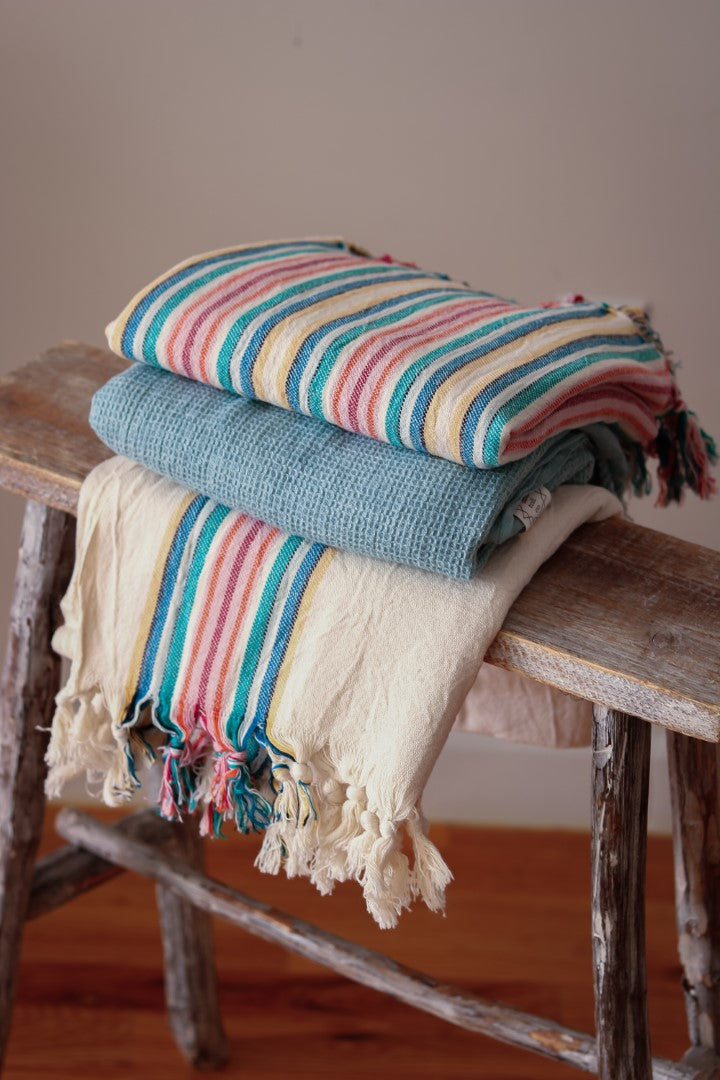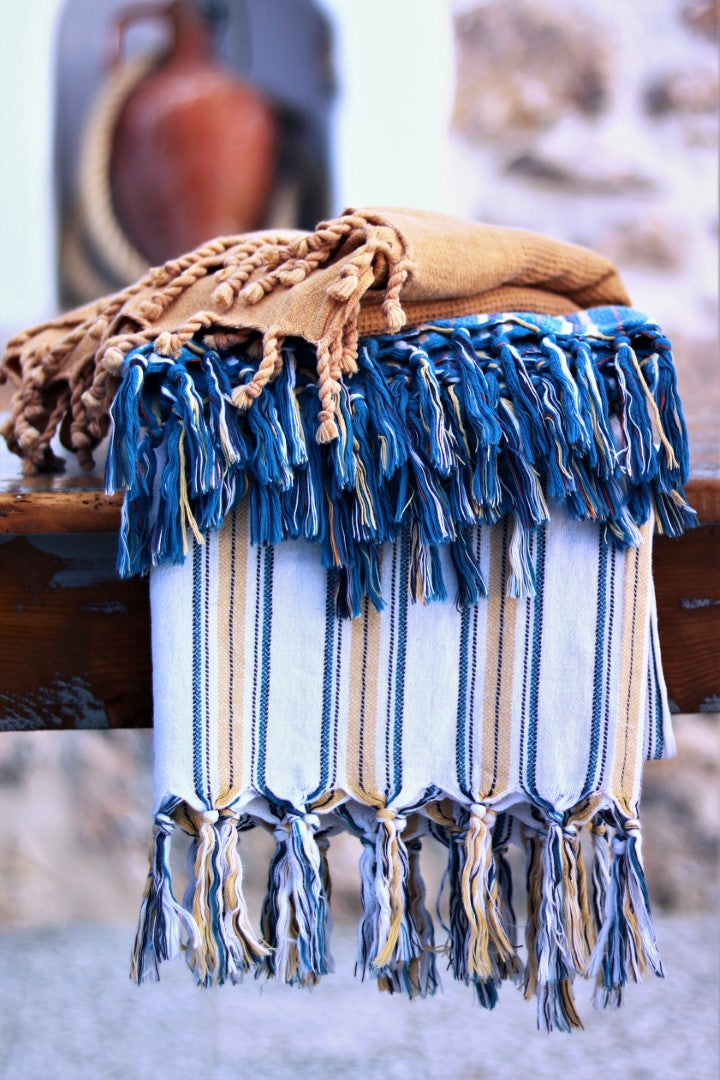What Makes the Kimono the Ultimate Swimsuit Coverup
Think of the swimsuit coverup kimono as the effortless blazer of the beachwear world. It's that one single piece that has the power to instantly pull your entire look together with an air of grace and style. It’s so much more than just something you toss over a wet bikini; it’s a genuine fashion statement that beautifully bridges the gap between casual poolside lounging and a chic sunset dinner.
The real magic is in its unique structure. The combination of an open front, a graceful, flowing drape, and those signature wide sleeves creates a silhouette that flatters just about everyone and moves beautifully as you walk. This design perfectly marries traditional Japanese aesthetics with modern, lightweight fabrics made for sun, sand, and water. It's this fusion of timeless form and real-world function that truly sets it apart from other options like a simple sarong or tunic.
The Defining Features
A kimono coverup is less about its shape and more about the feeling of relaxed elegance it creates. A few key characteristics are what make it such a beloved and enduring piece:
- Open-Front Design: This is all about easy layering. It lets you show off your swimsuit underneath while still offering light, breezy coverage.
- Flowing Drape: The loose, unstructured fit isn't just for looks—it offers incredible comfort and breathability, which is essential for staying cool in warm weather.
- Wide Sleeves: This is the hallmark of a true kimono style. The sleeves add a touch of drama and sophistication while contributing to that airy, comfortable feel.
This sketch really breaks down the key features that make the swimsuit coverup kimono a classic.
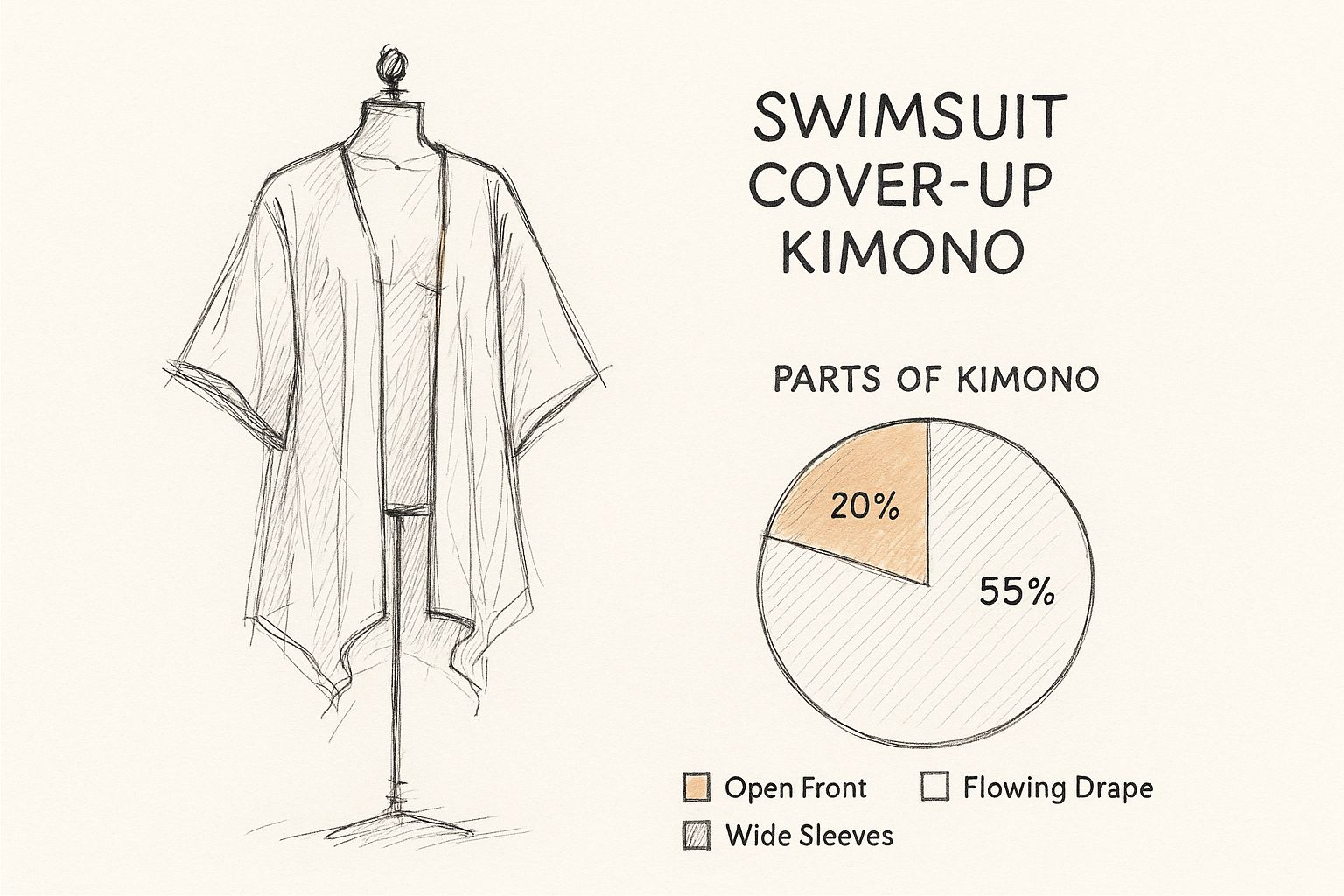
It’s the artful blend of these simple elements that results in a garment that feels both incredibly comfortable and undeniably chic.
A Symbol of Modern Resort Style
The kimono coverup’s popularity isn't just a fleeting trend; it reflects a bigger shift in what we want from our vacation wardrobes. We’re all looking for pieces that are as functional as they are fashionable, clothes that can effortlessly transition from one setting to the next.
This desire for stylish, multi-purpose beachwear is driving major growth in the industry. In fact, the global market for luxury beach cover-ups, including these elegant kimono styles, is projected to hit $4.29 billion by 2025. If you're interested, you can learn more about this growing market trend and what it signals for the future of resort fashion.
How to Choose the Right Fabric and Fit
Finding the perfect swimsuit coverup kimono really comes down to two things: the fabric and the fit. It’s a bit of a balancing act. The right material feels amazing against your skin and can handle the heat and humidity, while the perfect silhouette flatters your body and suits the vibe you're going for.
Think of it this way: what works for a dry, scorching day in Palm Springs might not be the best choice for a sticky, tropical afternoon in Bali. The secret is knowing what to look for. A breezy chiffon kimono might be perfect for lounging poolside, but natural fibers like cotton or linen are your best bet when the humidity really kicks in.
Finding Your Ideal Material
The fabric is where it all starts. It determines how the kimono hangs, how it breathes, and ultimately, how comfortable you'll be. Each material brings something different to the table, so let's break down the most popular choices.
Swimsuit Kimono Fabric Comparison
To make it easier, here's a quick comparison of the most common fabrics you'll find for a kimono coverup.
| Fabric | Key Characteristics | Best For |
|---|---|---|
| Chiffon & Sheer Synthetics | Ultra-lightweight, dries almost instantly, creates an ethereal, flowing look. | Poolside lounging, upscale beach clubs, and adding a touch of glamour without any extra warmth. |
| Cotton & Linen | King of breathability. Natural, absorbent, and allows for excellent airflow. | Hot, humid climates where you need your clothing to work with you to stay cool and comfortable. |
| Silk Blends & Viscose | Luxuriously soft with a beautiful, fluid drape that hangs elegantly on the body. | Transitioning from a day by the water to a sophisticated beachside dinner or sunset cocktails. |
At the end of the day, the right fabric makes all the difference. Cotton and linen are fantastic choices if you're serious about staying cool; you can read more about why in our guide to breathable fabrics for hot weather.
Choosing a fabric isn’t just about aesthetics; it’s about comfort. The goal is to find a material that feels like a second skin, allowing you to move with ease and confidence whether you're by the water or at a seaside cafe.
Selecting the Perfect Silhouette and Length
Once you have your fabric picked out, it's time to think about the cut. The silhouette of your swimsuit coverup kimono has a huge impact on your overall look, so you want to find a style that feels like you.
A shorter, waist-length kimono gives off a playful, casual vibe. It’s the perfect partner for high-waisted bikini bottoms or a pair of denim shorts, offering just a little bit of coverage without hiding your swimsuit.
On the other hand, longer duster-style kimonos that hit around the calf or ankle are all about drama and elegance. They’re incredibly versatile, giving you more sun protection while creating a sophisticated silhouette that can easily carry you from the beach to a nice dinner. It all comes down to the look you want and where you plan on wearing it.
From Tradition to Trend: The Kimono's Fashion Journey
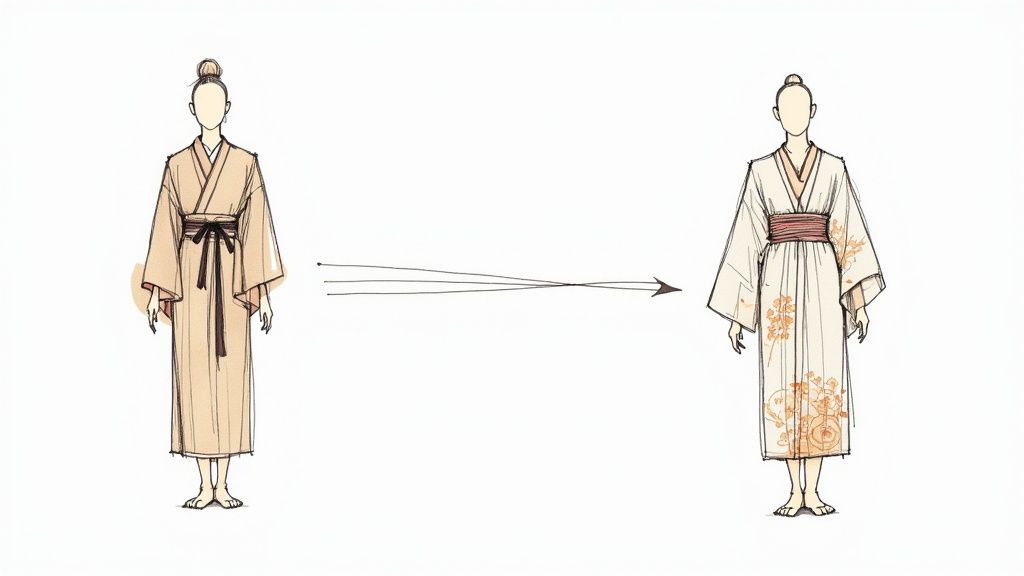
Every swimsuit coverup kimono you see today carries centuries of history in its very threads. This now-iconic beach staple didn't start its life by the ocean, but in the rich cultural landscape of Japan, where the traditional kimono has long been a symbol of grace and artistry. The name itself simply means "thing to wear," and for generations, it was the primary garment for everyone.
The elements we love in a modern coverup—the clean, T-shaped cut, the flowing silhouette, and those dramatic, wide sleeves—are all direct descendants of this classic design. These features weren't just for looks; they were designed for comfort and freedom of movement, principles that happen to be perfect for the relaxed vibe of beach and resort life. It’s a beautiful thing when a timeless design finds a new purpose in a completely different world.
The Yukata: The Bridge to Modern Style
If you want to pinpoint the direct inspiration for the beach kimono, look no further than the yukata. This more casual, unlined kimono, traditionally made from cotton, was worn after bathing or during fun summer festivals. It was all about relaxed comfort and breathability—the perfect blueprint for anyone looking to create an effortless piece for a sunny getaway.
Fashion designers saw the potential in the yukata's easy elegance. They kept the graceful structure but began experimenting, swapping traditional cotton for even lighter, quicker-drying fabrics like airy chiffon and sheer synthetics. This smart adaptation kept the garment's spirit alive while making it practical for a modern, global audience.
When you understand this heritage, you start to see your favorite coverup differently. It’s not just a piece of fabric; it’s a silhouette refined over generations, connecting a rich past with your own present-day style.
This deep connection to its roots still has a major impact. Japan’s domestic kimono market is valued at around $1.5 billion USD annually. And while that includes formal wear, the surging popularity of casual, inspired styles has fueled a global fascination. The international market for kimonos and accessories is even projected to grow at a 7% compound annual rate through 2033.
This shows just how much Japanese aesthetics continue to shape what we wear by the water. You can discover more about the global kimono market's expansion and see how this timeless garment is influencing fashion worldwide.
Ways to Style Your Kimono Beyond the Beach
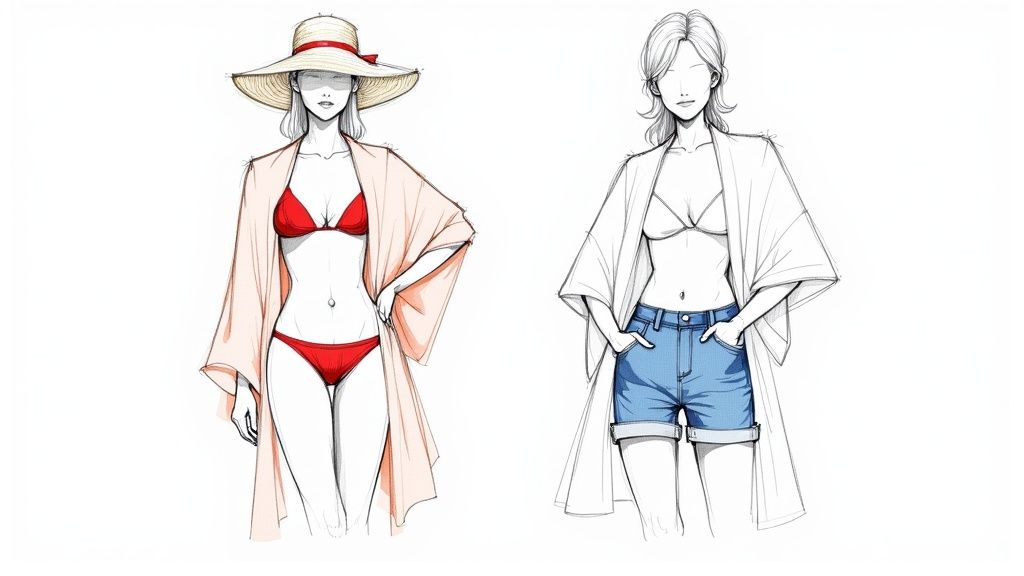
Don't relegate that gorgeous kimono to the back of your closet until your next beach trip. The real magic of a well-made kimono coverup is just how adaptable it is. With a little creativity, it can easily become one of the most versatile pieces you own, taking you from poolside lounging to city nights out.
Sure, the classic beach look is a no-brainer—toss it over a bikini with a wide-brimmed hat, and you're instantly chic. But that’s just scratching the surface. Its flowing shape and breezy fabric make it the perfect third piece for layering, proving its worth far beyond the sand.
Create a Casual Daytime Look
Think of your kimono as a stand-in for a light jacket or your favorite cardigan. It’s the easiest way to inject some color and pattern into a simple outfit, giving you that effortlessly cool, bohemian vibe that looks put-together without trying too hard.
Here are a couple of my go-to combinations for a laid-back look:
- With Denim Shorts: This is a classic for a reason. Throw your kimono over a simple tank and your favorite denim cutoffs. It’s the perfect outfit for a music festival, a stroll through the farmers' market, or just grabbing brunch.
- Over Jeans: For a look that offers a bit more coverage, layer your kimono over skinny or straight-leg jeans and a simple tee. Finish it off with a pair of ankle boots or some cute flats, and you’re good to go.
Whether you're chilling by the pool or exploring a new town, knowing how to style your kimono can make it the MVP of a memorable girls' weekend. It gives you that extra bit of coverage you want without making you overheat.
The secret to styling a kimono for everyday wear is to think of it as an accessory. It’s the final flourish that pulls your whole look together, adding a dose of personality to your wardrobe staples.
Elevate Your Evening Style
Who says kimonos are just for daytime? They can transition seamlessly into an elegant evening look. A longer, duster-style kimono, especially one in a silk blend or viscose, has a beautiful drape that can instantly dress up an outfit for a dinner date or drinks with friends.
Try layering it over a simple slip dress in a solid, complementary color—the kimono adds a touch of sophisticated drama and movement. Another great trick? Cinch the waist with a belt. This simple move creates a defined silhouette, transforming the kimono from a loose layer into a structured, dress-like piece. It's a small change that completely alters the feel of the outfit, proving just how hardworking this one garment can be.
How to Keep Your Kimono Looking Like New
When you find a beautiful swimsuit coverup kimono, you're investing in a piece you’ll want to wear for years. With just a little bit of care, you can keep it looking just as stunning as the day you bought it.
These coverups are usually made from light, airy fabrics, so a gentle touch is everything when it comes to preserving their color and shape.
Most kimonos, especially those crafted from chiffon, silk blends, or viscose, really do best with a simple hand wash. Think of it as a mini spa day for your favorite resort piece. The rough and tumble of a washing machine can be way too aggressive, leading to snags, stretching, or damage to lovely details like tassels and embroidery.
The Gentle Washing Method
When it comes to delicate fabrics, hand washing is your safest bet. It’s a quick and easy process that makes all the difference in keeping your kimono vibrant and perfectly intact.
- Get Ready: Fill a clean sink or a small basin with cool water. Hot water is a no-go, as it can make some colors bleed and might even shrink the delicate fibers.
- Add a Mild Soap: A tiny amount of a gentle, pH-neutral detergent is all you need. Steer clear of harsh chemicals or anything with bleach.
- Soak and Swirl: Let the kimono soak for a few minutes, gently swirling it through the soapy water. Avoid any vigorous scrubbing or wringing, which is the fastest way to stretch out the fabric.
- Rinse It Out: Drain the soapy water and rinse your kimono under cool, running water until you don’t see any more suds.
If your kimono is made from a tougher material like cotton or linen, you might get away with using the delicate cycle on your machine with cold water—but always, always check the care tag first.
Pro Tip: Whatever you do, don't twist or wring out your kimono to get the water out. Instead, gently squeeze it or, even better, lay it flat on a thick towel, roll it up like a burrito, and press lightly to soak up the excess moisture.
Drying and Storing for Longevity
How you dry and store your kimono is just as crucial as how you wash it. The name of the game is preventing stretches and wrinkles.
Always air dry your kimono. You can either lay it flat on a fresh, dry towel or hang it on a padded hanger. Just keep it out of direct sunlight, which can cause the beautiful colors to fade over time.
Once it's dry, a quick pass with a steamer will smooth out any lingering wrinkles. When you’re ready to store it for the season, fold it loosely and keep it in a cool, dry spot.
This simple routine will ensure your go-to swimsuit coverup kimono stays in your rotation for many vacations to come. The principles are pretty similar for any fine textile. For more tips on looking after special fabrics, take a look at our guide on how to care for your Turkish towel.
Finding Sustainable and Artisan Kimono Coverups
As we all become more thoughtful about what we buy, this conscious mindset is finally making its way to our beach bags. It’s a welcome change that pushes us to look beyond a cute pattern and ask about the story behind our clothes, especially something as lovely as a swimsuit coverup kimono.
Choosing a sustainable piece is really about picking materials that are gentler on our planet. Think soft organic cotton, airy linen, or even modern fabrics made from recycled fibers. Not only do these materials feel amazing on sun-warmed skin, but they also signal a commitment to a lighter environmental footprint. It’s a simple way to turn a style choice into a statement.
The Beauty of Handcrafted Artistry
Beyond the fabric itself, there’s a real movement back toward celebrating true craftsmanship. You'll find many smaller brands championing age-old techniques like hand-looming and natural dyeing to create kimono coverups that are genuinely one-of-a-kind. Each one carries a story of skill passed down through generations.
When you invest in an artisan-made kimono, you're doing more than just buying another piece of clothing. You're directly supporting skilled craftspeople and their local communities. It’s a chance to own something with a soul, something worlds away from a factory-made garment. You can get to know the incredible people behind this work by reading about our beloved artisan partners.
An artisan kimono isn't merely a coverup; it’s wearable art. The slight variations in the weave or the subtle inconsistencies in the dye are not flaws but marks of authenticity, reminding you that a human hand created your garment with care.
This kind of mindful shopping is definitely making waves. While the global swimwear market is huge—projected to hit $30.59 billion by 2032—the space for high-quality, eco-conscious brands is growing fast. In fact, it's expected to grow at a rate of 6.47% each year through 2030. You can explore more swimwear market trends on Fortunebusinessinsights.com. This trend shows a clear desire for pieces that look good and do good, empowering you to build a vacation wardrobe that truly reflects your values.
Common Questions About Swimsuit Kimonos
Once you start looking into the world of swimsuit kimonos, a few practical questions almost always pop up. Let's walk through some of the most common ones so you can shop smarter and wear your new favorite piece with complete confidence.
One of the biggest questions I hear is, "Can I actually wear this away from the beach?" The answer is a huge yes! In fact, that's where the real magic of a well-made kimono lies. Its versatility is its greatest superpower.
Think of it as a breezy, unstructured jacket. You can easily toss a kimono over a simple tank top and jeans for a chic weekend coffee run, or pair it with cutoff shorts for a relaxed festival look. The trick is to choose fabrics like high-quality cotton, linen, or a soft viscose blend that drape beautifully and don't scream "poolside only."
Tips for Petite Frames
If you're on the shorter side, you might worry that a flowing kimono will completely swallow you up. I get it. But with a few simple adjustments to the proportions, a kimono can look absolutely incredible on a petite frame. It’s all about creating balance.
A few guidelines can make all the difference:
- Go for Shorter Lengths: Look for styles that hit around your hip or mid-thigh. This gives you that gorgeous, flowing movement without making your legs look shorter.
- Grab a Belt: Cinching a longer kimono at your natural waist works wonders. It instantly creates a silhouette, breaking up the long line of fabric and putting the focus back on your shape.
- Stick to Lighter Fabrics: Sheer materials like chiffon or gauzy cotton blends have less bulk, which keeps the garment from looking too heavy or overwhelming on a smaller frame.
A great kimono should feel like an extension of your personal style, not something you're hiding under. For petite women, it’s about finding a cut that works with your proportions, not against them.
Packing Your Kimono for Wrinkle-Free Travel
Okay, so how do you pack your beautiful kimono without it arriving at your destination looking like a crumpled mess? The secret is to avoid hard creases from the start.
The best method is to roll, not fold. Start by laying your kimono out on a flat surface and smoothing it out. Fold the sleeves in toward the center, then tightly roll the whole thing up from the bottom into a neat little log. This simple technique prevents those sharp, deep-set wrinkles that folding creates.
When you pack, tuck the rolled kimono near the top of your suitcase so it won’t get squashed by heavier items. As soon as you arrive, hang it up. A little steam from the shower will help any minor travel wrinkles fall right out, making sure it's ready for its vacation debut.
Discover timeless, artisan-made pieces that blend Mediterranean comfort with modern style at Anatolico. Explore our collection of beautifully crafted kimonos, robes, and beachwear at https://www.anatolico.co.

